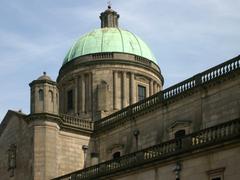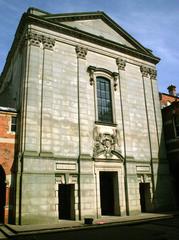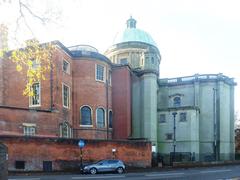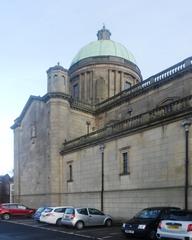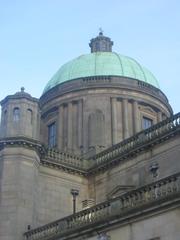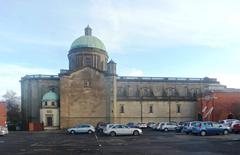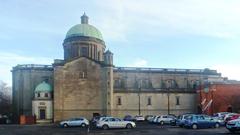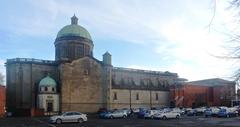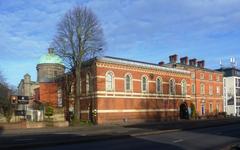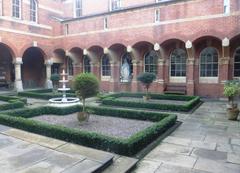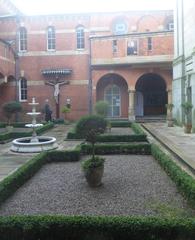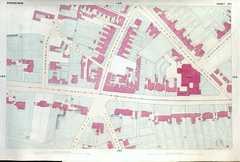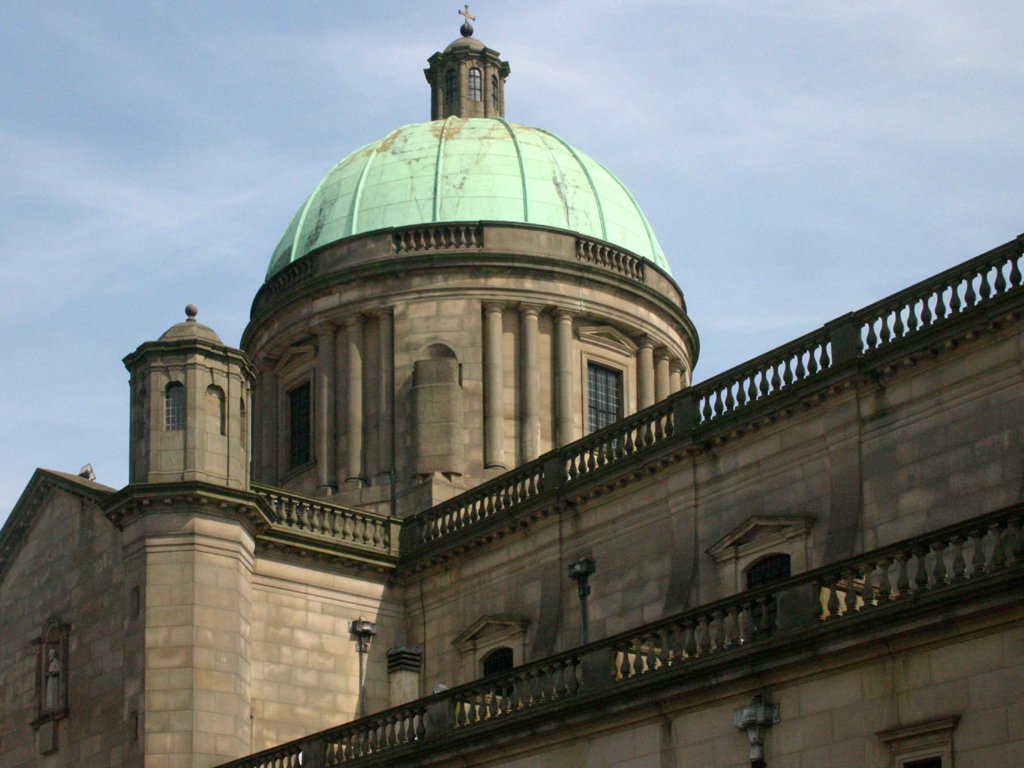
Birmingham Oratory Visiting Hours, Tickets, and Comprehensive Visitor Guide
Date: 14/06/2025
Introduction
Nestled in the historic Edgbaston district of Birmingham, the Birmingham Oratory—officially the Oratory of Saint Philip Neri—is a distinguished landmark of religious, architectural, and cultural significance. Established in 1848 by St. John Henry Newman, one of the 19th century’s most influential English religious figures, the Oratory stands as a testament to the revival of Oratorian spirituality in England. Its majestic Edwardian Baroque church, rich interiors, and vibrant liturgical life make it a compelling destination for pilgrims, history enthusiasts, and admirers of sacred art and architecture.
This detailed guide covers everything you need to plan a visit: from Birmingham Oratory visiting hours and ticket information to accessibility, transport, guided tours, and nearby attractions. It also explores the Oratory’s historical roots, spiritual legacy, and its ongoing role in the community. For the most current information, always consult the Birmingham Oratory official website and explore additional resources such as British Pilgrimage.
Table of Contents
- The Oratorian Movement: Origins and Newman’s Legacy
- Evolution of the Birmingham Oratory Complex
- Architectural and Artistic Highlights
- Worship and Liturgical Life
- Practical Visitor Information
- Guided Tours and Events
- Notable Sites Within the Oratory
- Community and Cultural Impact
- FAQs
- Visuals and Interactive Resources
- Summary and Visiting Tips
- Sources
The Oratorian Movement: Origins and Newman’s Legacy
The Oratorian Congregation was founded in 16th-century Rome by St. Philip Neri, emphasizing prayer, contemplation, and community service. St. John Henry Newman brought this spiritual tradition to England in 1848, establishing the Birmingham Oratory. His intellectual and pastoral influence continues to shape the Oratory’s mission, and his canonization in 2019 has further elevated its international significance (Birmingham Oratory official site; Birmingham World).
Evolution of the Birmingham Oratory Complex
After relocating to Edgbaston in 1852, the Oratorians initially constructed a temporary church and Oratory House. The present church, dedicated to the Immaculate Conception, was completed between 1903 and 1909, designed by E. Doran Webb. The complex includes the former Oratory School buildings—founded by Newman in 1859—and parish facilities. The Oratory is Grade II* listed for its architectural and historical importance (Cardinal Newman and the Church of the Birmingham Oratory: A History and a Guide; Birmingham Oratory History).
Architectural and Artistic Highlights
The Oratory’s grand Edwardian Baroque design, Italianate dome, and twelve imported marble pillars have earned it the moniker “Birmingham’s Little Rome.” The interior features rare marbles, intricate mosaics, and historic confessionals crafted by artisans from across Europe. Notable sites include:
- Shrine of St. John Henry Newman: The resting place of Newman’s relics, a focal point for pilgrimage.
- St. John Henry Cardinal Museum: Showcases Newman’s personal effects, correspondence, and vestments.
- Relics and Sacred Art: Including the skeleton of St. Valentine and historic organs.
- Peaceful Courtyard: A tranquil space for reflection and community gatherings.
Natural lighting from the dome’s windows and a tunnel-vaulted ceiling contribute to the church’s serene atmosphere (Visit Birmingham).
Worship and Liturgical Life
The Oratory is renowned for its solemn liturgies and musical excellence. Daily Masses are offered in both English and Latin (Extraordinary Form), with High Masses and Sung Vespers on Sundays and major feast days. The Oratory choir and organists uphold a tradition of sacred music, and the church regularly hosts special liturgies, devotions, and concerts open to all (Birmingham Oratory).
Sample Sunday Schedule:
- 7:30 am Mass (Latin)
- 8:30 am Mass (English)
- 10:30 am High Mass (Latin)
- 12:15 pm Mass (English)
- 4:30 pm Sung Vespers & Benediction (Latin)
- 5:30 pm Mass (English)
Weekday Masses: 7:30 am, 12:30 pm (English), and 5:45 pm (Latin).
Practical Visitor Information
Visiting Hours
- Monday–Friday: 7:00 am – 4:00 pm
- Saturday: 8:30 am – 1:30 pm & 4:00 pm – 7:00 pm
- Sunday: 8:00 am – 1:30 pm & 4:00 pm – 7:00 pm
The St. John Henry Cardinal Museum is open Thursday and Friday from 11:00 am to 1:00 pm, Saturday from 11:00 am to 3:00 pm. Appointments can be arranged outside these times (British Pilgrimage).
Admission and Tickets
- Entry: Free of charge; voluntary donations are appreciated.
- Special Events: Some concerts or lectures may require advance booking.
Accessibility
- Wheelchair access at the main entrance.
- Accessible restrooms and designated disabled parking.
- Visitors with special needs should contact the Oratory for tailored assistance.
Getting There and Parking
- Address: 141 Hagley Road, Edgbaston, Birmingham, B16 8UE
- By Bus: Multiple routes serve Hagley Road, connecting with city centre and Birmingham New Street Station.
- By Train: Birmingham New Street Station, 1.5 miles away, links to buses and taxis.
- By Car: Limited on-site parking via Plough and Harrow Road; additional public parking nearby.
Amenities and Nearby Facilities
- Restrooms (including accessible).
- Informational leaflets and devotional items available.
- No on-site café, but Edgbaston offers dining and refreshment options within walking distance.
Guided Tours and Events
Guided Tours:
Available by prior arrangement, led by knowledgeable volunteers who provide in-depth insights into the Oratory’s history, architecture, and spiritual significance (Visit Birmingham). Group and educational tours are welcomed.
Special Events:
The Oratory hosts concerts, heritage open days, and themed events such as Tolkien Weekend, celebrating its connection to J.R.R. Tolkien. Participation in Birmingham Heritage Week offers exclusive tours and lectures. Always check the official website for upcoming events.
Notable Sites Within the Oratory
- Shrine of St. John Henry Newman: Pilgrimage site for devotees and historians.
- St. John Henry Cardinal Museum: Displays Newman’s personal and liturgical artifacts.
- Relics: Including St. Valentine’s skeleton and other sacred objects.
- Historic Organ and Canopies: Artistic and musical heritage pieces.
Community and Cultural Impact
The Oratory’s mission extends beyond worship, with active community outreach, social initiatives, and educational programs inspired by St. Philip Neri and St. John Henry Newman. It supports local charities, hosts parish groups, and collaborates with cultural institutions.
The Oratory’s literary heritage includes its connections to J.R.R. Tolkien, whose childhood was shaped by the community (Oratory School History).
Frequently Asked Questions (FAQ)
Q: Is there an admission fee?
A: No, entry is free; donations are encouraged.
Q: Are guided tours available?
A: Yes, by advance arrangement via the Oratory’s website.
Q: Is the Oratory wheelchair accessible?
A: Yes, with accessible entrances and facilities.
Q: Can I attend Mass if I am not Catholic?
A: Yes, all are welcome to attend respectfully.
Q: Is photography permitted?
A: Discreet photography is allowed outside of services; avoid flash and always check signage.
Q: Are there parking facilities?
A: Limited on-site parking; public transport is recommended.
Visuals and Interactive Resources
Visitors are encouraged to view the virtual tour for an immersive online experience. High-quality images with descriptive alt text (e.g., “Birmingham Oratory architecture” and “Birmingham Oratory interior”) are available on the official website. Interactive maps and downloadable audio guides (via the Audiala app) further enrich the visitor experience.
Summary and Visiting Tips
The Birmingham Oratory blends profound religious heritage, architectural splendor, and community engagement in one remarkable site. Visitors can attend beautiful liturgies, explore the museum, join guided tours, and enjoy tranquil spaces for reflection. Its central Edgbaston location makes it an ideal base for exploring other Birmingham landmarks. For the latest visiting hours, event schedules, and tour bookings, always consult the Birmingham Oratory website.
Visiting Tips:
- Check service and event times in advance
- Engage with guides and volunteers for deeper insights
- Respect the sacred environment
- Consider combining your visit with nearby heritage attractions
Sources
- Birmingham Oratory official website
- Birmingham Oratory: Visitor Information
- British Pilgrimage: Birmingham Oratory
- Visit Birmingham: The Hidden Beauty of Birmingham’s Oratory
- Cardinal Newman and the Church of the Birmingham Oratory: A History and a Guide
- Oratory School History
- Birmingham Oratory History
- Hikersbay: Birmingham Tourist Information
